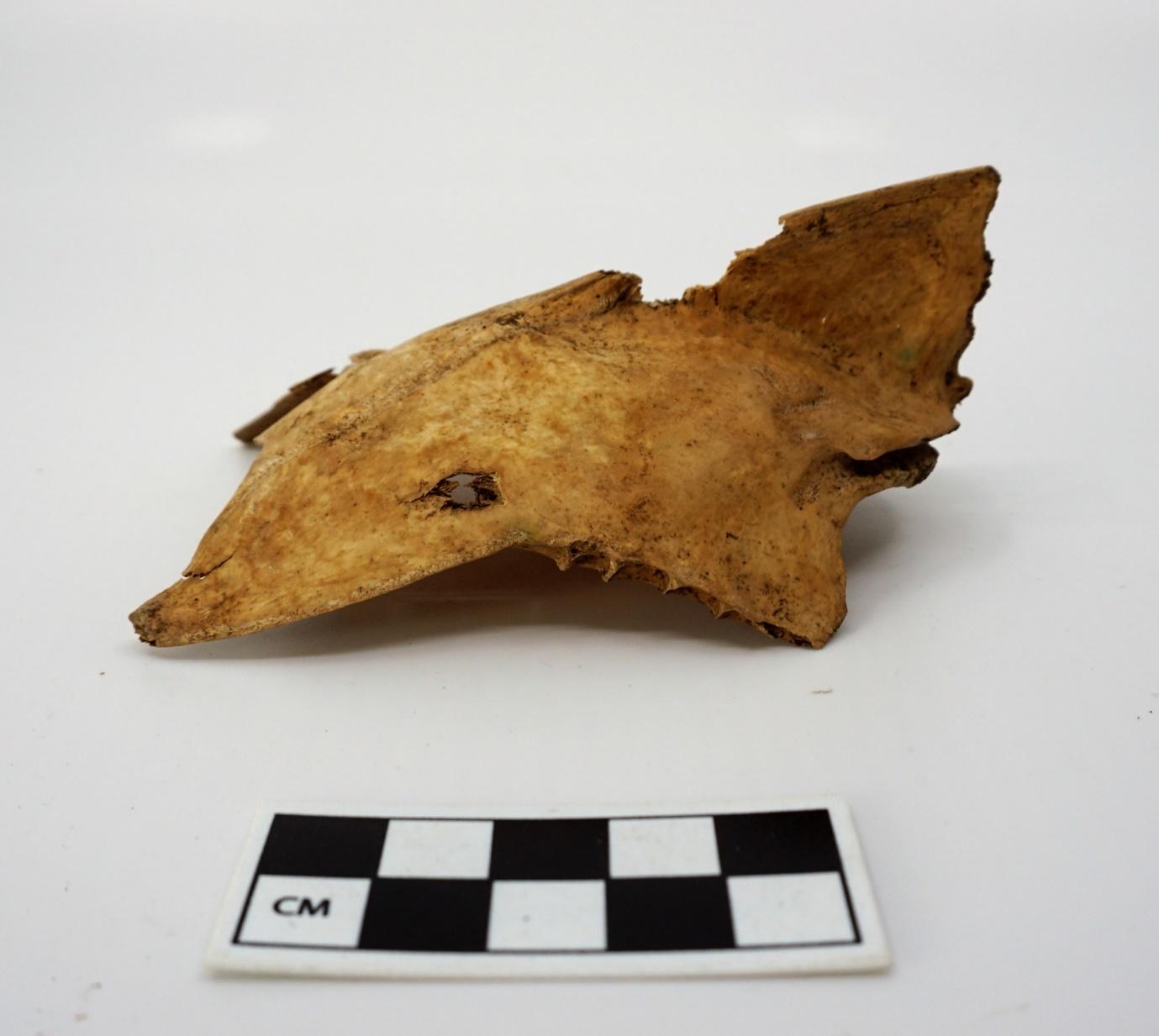
4 minute read
Analysis methods
The analysis of the animal bone collection from Litlibær was performed by zooarchaeologist
Albína Hulda Pálsdóttir and Indriði Skarphéðinsson, BA student in Archaeology at the
University of Iceland between May and December 2018. The analysis was done at the
Agricultural University of Iceland, Keldnaholt using the Icelandic ZooArch reference collection
(Albína Hulda Pálsdóttir & Elísa Skúladóttir, 2018).
Basic data was recorded through the NABO Zooarchaeology working group NABONE system 9th edition which combines an Access database with specialized Excel spreadsheets.
The NABONE package allows application of multiple measures of abundance, taphonomic
indicators, and skeletal element distribution (North Atlantic Biocultural Organization
Zooarchaeology Working Group, 2010).
Figure 1: Dog skeleton with major bone elements labeled (Davis, 1987, p. 54; Reitz & Wing, 2008, p. 364).
All teeth and bones were identified to species and element (Figure 1) when possible
and basic taphonomic indicators recorded. Texture of bones was recorded following the York
system (Harland, Barrett, Carrott, Dobney, & Jaques, 2003) to get an overview of the general
state of preservation of the collection. Elements were generally not sided. When aging sheep,
goat and cattle bones Grant’s (1982) dental wear system was used and O’Connor (O’Connor,
2003, p. 160) for age categories. All teeth and mandibles with recorded tooth wear were also
numbered and packed individually in bags.
All measured elements got a database number and were packed individually. Any
elements with pathologies were also numbered and packed individually. For descriptions of
pathology the system of O’Connor (2003, pp. 188–192) was used.
For distinctions between sheep (Ovis aries) and goat (Capra hircus) bones the
standards of Zeder & Lapham (2010) were followed. Phalanges were not separated into
sheep and goat since the criteria does not seem to work well for North-Atlantic material
(AHP, personal observation). For identification of seal bones Hodgetts (1999) and Storå
(2001) were used in addition to the reference collection. Seal bones are hard to identify to
species due to high inter-species variation (Hodgetts, 1999, p. 296) and there is a limited
number of seals in the Icelandic ZooArch reference collection at present (Albína Hulda
Pálsdóttir & Elísa Skúladóttir, 2018). Speciation of seal bones requires a good reference
collection with multiple individuals of each seal species likely to be found in the area of
different sex and age classes. Therefore, seal bones are not identified to species in this report, just to size class. Phocid species/PSP are bones that are clearly seal but can’t be put into a size category. Large Phocid species/LP are bones which likely come from seals the size
of the bearded seal (Erignathus barbatus), grey seal (Halichoerus grypus) or hooded seal (Cystophora christata). Small Phocid species/SP are bones from a seal the size of harbour seal
(Phoca vitulina), harp seal (Phoca groenlandica) or ringed seal (Phoca hispida).

Figure 2: Bird skeleton with element names (Cohen & Serjeantsson, 1996).
Bird bones (Figure 2) were identified using the Icelandic ZooArch reference collection
and identification manuals (Bochenski & Tomek, 2009; Cohen & Serjeantsson, 1996). Around
75 species of birds regularly nest in Iceland and around 370 species of birds are recorded as having been seen in Iceland (Náttúrufræðistofnun Íslands, n.d.). To confidently identify birds
bones to species when species are closely related and of similar size skeletons from at least 2-3 individual of each species are needed for a high quality identification (Bocheński & Tomek, 1995). To avoid over identification where there Icelandic ZooArch reference
collection does not have enough reference specimen’s gulls (Laridae) have not been
identified to species but for all gull bones size category has been noted. Same applies to auk species (Alcidae). Cormorants/shags have (Phalacrocorax spp) not been identified to species
either due to lack of reference material.
Fish bones were identified using the Icelandic ZooArch reference collection and
available databases and manuals (“Archaeological Fish Resource,” n.d.; “Idaho Virtual
Museum—Osteo Bony Fishes,” n.d.; Perdikaris, Krivigorskaya, McGovern, & Pirjo, 2004;
Wheeler, 2009).
The zooarchaeological (rather than taxonomic) categories of “small terrestrial
mammal (STM)” (cat-fox sized), “medium terrestrial mammal (MTM)” (pig-sheep-goat-large dog sized) and “large terrestrial mammals (LTM)” (cow/horse sized) mainly include vertebral,
rib, and long bone shaft fragments that could not be securely identified further. They are
probably mostly from domestic mammals already identified on other elements. Unidentified
mammal fragments (UNIM) are mammal bones which can’t be identified further.
Unidentified fragment (UNI) are bone fragments, usually very small or badly preserved which
can’t be placed in any of the above categories.
Land mammal element measurements were done according to the metrical standard
of von den Dreisch (1976) with digital callipers to the mm. Domestic fowl (Gallus gallus)
bones were measured following von den Dreisch (1976) but other bird bones were not
measured. Seal bone measurements followed Ericson og Storå (1999). Fish bones were
measured following the York system (Harland et al., 2003).








